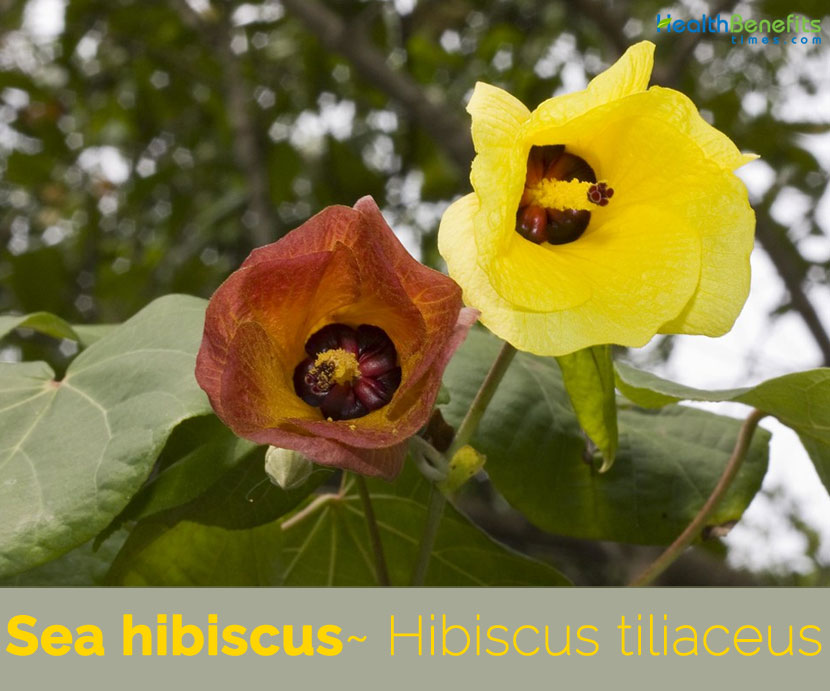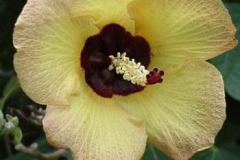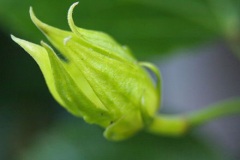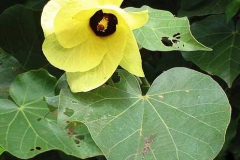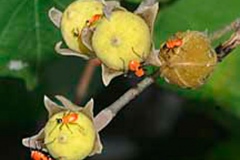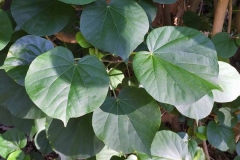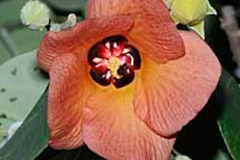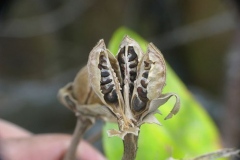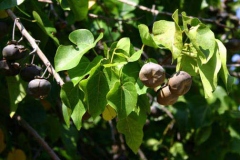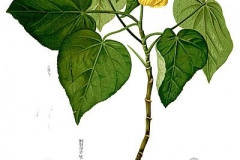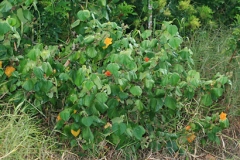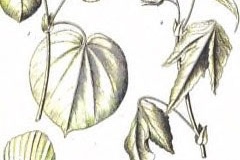| Sea Hibiscus Quick Facts | |
|---|---|
| Name: | Sea Hibiscus |
| Scientific Name: | Hibiscus tiliaceus |
| Origin | Tropical shores of the Pacific and Indian oceans |
| Colors | Green when young turning to brown as they mature |
| Shapes | Capsules sub globose to ovoid, 2.5-3 cm long, long-pointed, hairy |
| Taste | Bitter |
| Health benefits | Beneficial for coughs, sore throats, tuberculosis, skin conditions, eye injuries and infections, stomach pain, fractured bones and sprained muscles, gonorrhea, and fever |
| Name | Sea Hibiscus |
|---|---|
| Scientific Name | Hibiscus tiliaceus |
| Native | Tropical shores of the Pacific and Indian oceans. Today it is cultivated or naturalized throughout the tropical and subtropical regions of the world |
| Common Names | Cottontree, Beach Hibiscus, Bladder Ketmia, Coast Hibiscus, Coastal Hibiscus, Coast Cottonwood, Coastal Cottonwood, Cottonwood Hibiscus, Green Cottonwood, Hawaiian Tree Hibiscus, Lagoon Hibiscus, Linden Hibiscus, Mahoe, Mahuat, Mountain Mahoe, Native Hibiscus, Norfolk Hibiscus, Native Rosella, Kurrajong, Sea Hibiscus, Sea Rose Mallow, Tree Hibiscus, Yellow Mallow Tree, Cottonwood, Coast Hibiscus, Majagua, Gatapa |
| Name in Other Languages | Afrikaans : Kusvuurblom, Wildekatoenboom Australia: Malwan, mapandhurr, native hibiscus, native rosella, yal Bengali: Bhola, Cēlaraā (চেলৱা) Chelwa Brazil : Algodão Da Praia, Guaxima-Do-Mangue, algonodero-de-playa Chinese: Huang jin (黄槿) Chuuk : Kilife Cook Islands : Au Cuba: Majagua Czech : Ibišek Lípovitý Dominican Republic: Majagua de Cuba English: Bladder ketmia, Cotton tree, Cottonwood, Hawaiian tree hibiscus, Lagoon hibiscus, Linden hibiscus, Mountain mahoe, Sea hibiscus, Tree hibiscus, Mahoe, beach hibiscus; coast hibiscus; cottonwood hibiscus; green cottonwood; lime-tree-leaved hibiscus; linden hibiscus, Norfolk hibiscus, sea rosemallow; yellow mallow tree, mahaut Estonian : Pärnhibisk Fiji : Vau, Vaundamu, Vaundamundamu, Vaundina, Vauleka, Vaundra French: Purau, Bourao, hibiscus tilléiforme, mahot blanc, hibiscus tilléiforme German: Linden-Roseneibisch Guam : Pago Haiti: Coton mahaut, grand mahaut, maho fran Hindi: Hau, Hau Ka‘Eka‘E Pola, attuparathi, bala, banish, belapata, bellipata, bhoia, birparutti, bola, chelwa, etagogu, kattupoovarasu, nirparathi, nirparuthi, olapparuthi, pooparuthi, safed chilka, velipparuthi, Bola (बोला) Indonesia : Waru, Waru Laut, Baru, babaru Jamaica: Seaside mahaut Japanese: Yama-asa, Oo-hamaboo (オオハマボウ) Kannada: Bilipatta, Kaark Bendu, Samudra Theeradatthi Kiribati : Te Kiaiai, Te Rau Konkani: Bellipata, Khari kapusi Kosrae : Lo Laos : Hou Sua, Ta Sua Madagascar: Afopotry, Varo, Aviavy Malayalam: Nirparatthi, Nirparatti, Nirparuthi, Nirparutti, Paratti, Pariti, Paritti, Paroottee, Parutti, Talipparutti Malaysia : Akar Seregang, Baru, Baru-Baru, Baru Laut, Bebaru, Embaru, Dedap Laut, Mebaru, Kelaut, Selaut Malay: Baru-baru, Bebaru Marathi: Baelsing, Belipata,belapata, Bellipata, Belpata, Bhotee, Kharikapusi, Mothi Potaare, Varadhaa, Varanga Marquesas : Fau Toui, Fau Maoi Marshall Islands : Lo Myanmar : Thin Ban Netherland: Waroe New Caledonia : Vo, Vole Niue : Fou Oriya: Kurubeli, Baniya Palau : Ermall Panama : Algondoncillo, Hibisco Marítimo, Majagua, Mahoe Papua New Guinea: Varvar, Bang, Pow, Valu Philippines : Laogo, Majagua, Malubago, Mayambago, Balibago, Ragindi, Bago, Mayambago, Bauan, Marakapas, Malabagu, Hanot, Mulabago, Malibago, Balabago, Malabago, Danglog, Malibago, Lambagu, Dangliu, Malabago, Malubago, ganglog, labágn Pohnpei : Kalau Portuguese: Algodão da praia, algonodero-de-playa Puerto Rico: Emajagua Samoa : Fau Sanskrit: Bala Seychelles: Mahoe, varre Solomon Islands : Ayiwo, Fa‘Alo, Fa‘Ola, Fakasu, Kwara‘Ae Spanish: Algondoncillo, Hibisco marítimo, Majagua, Mahoe, Emajagua, majaguito de playa Sri Lanka : Beli Patta Swedish : Strandhibiskus Tahitian : Purau Tamil: Attuparuthi, Nirparathi, Nirparutti, Nirpparutti, Potari Telegu: Cherigogu, Erragogu, Ettagogu Thai: Po fai, Po na, Pho thale, Po thale, Khamin Naang Matsee, tree mallo, hau tree Tonga : Fau Tuvalu : Fautu’u, fau USA: Hau Vanuatu : Burao, Var Vietnamese : Tra Bụp, Bụp Tra, Tra Làm Chèo, Tra Làm Chiếu Yap : Gaal |
| Plant Growth Habit | Large, stout, open-branched shrub or a small evergreen tree |
| Growing Climates | Common near beaches, mangrove swamps, river estuaries, growing well on mud, marl, sand, limestone, pastures, range lands and waste places, beaches, rivers, streams, riparian environment, inland areas and valleys |
| Soil | Adapted to a wide range of soils, from acid to alkaline, from well-drained to poorly drained, and will grow well on coral or quartz sands, marls or limestone-based soils |
| Plant Size | About 4–10 m (13–33 ft.), with a trunk up to 15 cm (5.9 in) in diameter |
| Bark | Smooth grey or light brown bark with fibrous inner bark, on a short crooked trunk to 15 cm in diameter |
| Twigs | Stout, with rings at nodes, becoming brown and hairless |
| Leaf | Sub orbicular, 10 to 15 centimeters long, green, smooth and shining on the upper surface, grayish and hairy on the under surface, with a pointed tip and heart-shaped base, and minutely toothed margins |
| Flower | Flowers many, few in each cluster, each with whitish hairy stalk 2-5 cm and grey-green hairy basal cup (involucre) 2 cm long, usually with 9-10 narrow pointed lobes. |
| Fruit Shape & Size | Seed capsules sub globose to ovoid, 2.5-3 cm long, long-pointed, grey-green hairy, splitting into five parts |
| Fruit Color | Green when young turning to brown as they mature |
| Seed | Seeds, three from each cell, brownish black, 3-5 mm long, hairless |
| Propagation | By seeds and from tips or hardwood cuttings or grafting |
| Taste | Bitter |
| Plant Parts Used | Leaves, bark, flower, root |
Plant Description
Sea hibiscus is a large, stout, open-branched shrub or a small evergreen tree that grows about 4–10 m (13–33 ft.) tall, with a trunk up to 15 cm (5.9 in) in diameter. The plant is found growing near beaches, mangrove swamps, and river estuaries, growing well on mud, marl, sand, limestone, pastures, range lands and waste places, beaches, rivers, streams, riparian environment, inland areas and valleys. The plant is adapted to a wide range of soils, from acid to alkaline, from well-drained to poorly drained, and will grow well on coral or quartz sands, marls or limestone-based soils, but also on heavier soils. It does not tolerate frosts and does best in full sun. It cannot tolerate prolonged drought and requires continual soil moisture. It is now grown as an ornamental in tropical and subtropical areas around the world. It has escaped gardens and naturalized along the coast in southern Florida where it is now considered to have invasive potential. The Bark is gray to light brown, smooth to slightly longitudinally fissure with horizontal cracks, becoming thick and rough with age. Twigs are stout, with rings at nodes, becoming brown and hairless.
Leaves
Large dark green simple leaves are heart-shaped to almost circular or broader than long, about 8-20 cm long and 6-15 cm across (3-8 inches long and 2.4-6 inches wide); 5- to 9-veined from the base, veins prominent, each of the main veins with a slit or elongated gland near the base. Leaves are velvety white to greyish, densely and finely tomentose below, olive-green and glabrescent (becoming hairless) on the upper surface. Apex shortly pointed; base deeply lobed; margins entire or minutely toothed. Petiole (leaf stalk) is up to 120 mm long, with stellate (star-shaped) hairs, sometimes hairless. Stipules (small appendages at the base of leaves) are broad, up to about 30 mm long and 15 mm wide, ovate-cordate, caducous (falling off during the life of the organism), sheathing the stem, falling off early to leave a scar almost all the way around the stem. In some Pacific islands there is a variant with bronze reddish green shoots and new leaves.
Flower
Flowers are typical of the Hibiscus genus, showy up to 120 mm in diameter, fragile, and shorty lived, falling the same day that they open. They are born in terminal or axillary, few flowered cymes (3-6 flowers), or else solitary. Individual flowers are cup shaped, with the corolla consisting of five radiating, obovate, lemon yellow petals 4-6 cm (1.6-2.4 in) long, dark maroon at the base. The central stamina column is covered in yellow anthers with a terminal, red, five parted style. The five sepals are elongated triangular and light greenish pink. The flowers fade to pink prior to falling. Flowering and fruiting may occur at any time of the year. The time to first flowering and fruiting is typically 2-3 years from seed.
Fruit
Fertile flowers are followed by light brown, ovoid or sub globose, dry capsules covered with golden hairs. They are about 2 cm (0.8 in) long, splitting into 5 segments and 10 cells of seeds at maturity. Fruiting may occur throughout the year. Vegetatively propagated plants may flower in less than a year while seedlings first produce mature fruits at about 2-3 years of age.
Seed
There are about 5-7 smooth, kidney shaped seeds per cell that are 4.5mm long and 3 mm wide. The seeds are rich brown to brown black in color, wrinkled, roughened and hairy. The seeds float and remain viable in seawater for months, and this has contributed to its vast diffusion.
Traditional uses and benefits of Sea Hibiscus
- medicinal uses of beach hibiscus is for coughs, sore throats, tuberculosis, skin conditions, eye injuries and infections, stomach pain, fractured bones and sprained muscles, gonorrhea, and fever.
- Flowers and the sap of the plant are widely utilized in a variety of medicines.
- An infusion of the leaves is used to aid in the delivery of a child and for postpartum discharges.
- Leaves are used in treating coughs and sore throats.
- Leaves are made into a paste and used as a poultice for sores, cuts, open wounds, boils and swellings.
- Bark and leaves are used medicinally, especially to relieve coughs, sore throats and tuberculosis.
- Bark and the young leaves are used to treat skin diseases in Tonga.
- Bark, on its own, is used in treating eye infections and injuries, and stomach-aches.
- An infusion of the bark is taken three times if the placenta is retained after the birth of the child.
- Fluid from the bark is used to induce menstruation in delayed menstrual period.
- The Cook Island Maoris use the bark, together with coconut bark or husk, to make an infusion used for bathing fractures.
- Leaves are wrapped around fractured bones and sprained muscles in Fiji.
- Juice from the leaves is used in treating gonorrhea.
- Acetone extracts from the leaves showed antibacterial activity.
- Treatment made from the leaves, roots and bark is given for fever.
- Flowers, roots and barks serve as herbal medicines in the Pacific.
- Flowers are used in a paste as a poultice for sores, cuts, boils and swellings in Tahiti, Cook Islands and the Marquesas Islands.
- Leaves or shoots are used to treat recurring sickness in Wallis and Futuna.
- Parts of the plant are used for cuts, tuberculosis and conjunctivitis in Solomon Islands.
- Preparation made from the leaves, roots and bark is administered for fever.
- In Amboina, root infusion is taken for fever and a decoction taken for fever in Java and Pahang, Malaysia.
- Leaves boiled with sugar are used for coughs and bronchitis in Java.
- Boiled leaves are rubbed over swellings and applied hot to boils and used for the hair in Java.
- Flowers are boiled in milk for use to treat earache in the Philippines.
- Young leaves are used medicinally as substitute for the European ‘folia althaeae’ and flowers likewise for ‘flores malvae’.
- Roots are used as an antifebrile and emetic, and the leaves and bark are used for the treatment of cough and bronchitis in Chinese folk medicine.
- Leaves are used in traditional medicine for fever, coughs and dry throat and the flowers for bronchitis, ear infections, and dysentery and chest congestion in Bangladesh.
- Bark is said to have contraceptive effect, which produces slimy mucus that is thought to have spermicidal effect, and hot leaf infusion is introduced into vagina to cause abortion in Hawaii.
- Leaves are used to alleviate fevers and soothe coughs, the bark as a therapy for dysentery and ear infections, flowers to treat abscesses and bark and flower as a mild laxative.
- For babies and young children, the flower buds are used.
- Leaf buds are chewed / swallowed for dry throat.
- Inner bark (with sap) is soaked and drunk for labor pains and rubbed on stomach.
- Flowers are said to be smoked with tobacco for anti-fertility in Melanesia.
- Fresh macerated bark makes water mucilaginous, and is prescribed in dysentery in Philippines.
- Decoction of the leaves is taken for sore throat, pneumonia, cough, tuberculosis and diarrhea in Papua New Guinea.
- Root decoction is drunk as a tonic and as a cure for hypertension, sickle cell anemia and irregular menstruation in Tanzania.
- An infusion of the flowers is drunk to solve respiratory problems in Madagascar.
- Flowers were used to treat bronchitis due to their emollient properties.
Culinary Uses
- Flowers are edible raw or cooked.
- Young leaves and green bark can also be eaten.
- Flowers can be cooked as a potherb.
- Leaves can be fermented into a sauce, used as a substrate for the tempeh starter culture, or boiled in salted water to make the beverage known as Onge tea.
- Young leaves are eaten in times of famine.
- Green bark is eaten in times of famine.
- Flowers are eaten as potherb or dipped in batter and fries.
- Tender young leaves are eaten cooked or boiled in salt water to prepare a beverage called Onge tea.
- Tender young leaves are also used to ferment soybean pulp into a sauce used as a substrate for tempeh starter culture.
- Roots are edible when cooked, and the inner bark, the cambium, can be suckled of its moisture and nutrients.
Other facts
- Fibers from the bark are made into cords, ropes, and traditional tapa bark cloth.
- Dried wood is used for fuel and fireworks.
- It is commonly planted as living fencing, whilst a creeping variety is planted as a wind-break in Hawaii.
- It has also been used to reforest eroded land, contain beach erosion, coastal rehabilitation, as a shade tree and a wind-break, especially along the seashore.
- It is used to manufacture a good quality rope which is can be used for caulking boats and is also used for plaiting mats.
- Green bark peels is used for making a fine fiber and is also beaten out to make traditional tapa bark cloth.
- Tapa cloth is produced by beating strips of bark on a flat surface with a wooden mallet.
- Very fine cloth can be made in this way, the more the bark is beaten the finer the cloth becomes.
- Larger sizes can be made by overlapping 2 pieces of bark and beating them together.
- Fiber from the bark has a wide range of other applications, including being used as canoe caulking, to make cordage for clothing and dancing skirts and kilts, coconut-climbing bandages or foot harnesses, mats, sandals, sewing tape, paint brushes, slings and kava strainers.
- The heartwood is a dark greenish brown; the sapwood whitish.
- The wood is light in weight, moderately soft and porous.
- The wood is useful for light construction, net floats and corks.
- It is used in wide range of purposes, including the outriggers of canoes, carving, house rafters, pig-tethering posts, spreaders, bailers, booms and occasionally hulls, fishing rods, hoists and floats, fishnet frames and handles, bows, fruit-picking rods, tools etc.
- It makes decent firewood, especially for slow smoking, and is used in making fire by friction.
- Paper manufactured from Sea hibiscus pulp is of low quality as the fiber are short (0.7-1.3 mm) and is only suitable for wrapping paper.
- Sea hibiscus is grown throughout the tropics mainly as an ornamental tree for landscaping and avenue planting.
- Sea hibiscus is widely used in Asian countries as a subject for the art of bonsai, especially in Taiwan.
- Stems and branches are long and flexuous and are used as living fence posts and fish kraals.
- Bark is used for making paper.
- Wood is used for light boat and canoe construction, planking, firewood, wood carvings, fishing nets, household implements, carts and canoe floats, sailing spars and axe handles.
- The leaves are fed to cattle.
- Young twigs, leafstalks, lower leaf surfaces, calyx and seed capsules densely covered with minute whitish grey, star-shaped hairs.
- The mahoe is often planted to stabilize sand dunes and, on muddy shores, to trap soil to reinforce the coastline. In India it is planted to prevent erosion on the banks of rivers and reservoirs.
- In Madagascar the fiber is also used for textiles and the bark for making bark cloth.
References:
https://www.itis.gov/servlet/SingleRpt/SingleRpt?search_topic=TSN&search_value=845742#null
https://pfaf.org/user/Plant.aspx?LatinName=Talipariti+tiliaceum
https://www.cabi.org/isc/datasheet/27132
https://plants.usda.gov/core/profile?symbol=HITI
https://en.wikipedia.org/wiki/Hibiscus_tiliaceus
https://npgsweb.ars-grin.gov/gringlobal/taxonomydetail.aspx?id=19096
http://www.agroforestry.net/images/pdfs/H.tiliaceus-beach-hibiscus.pdf
http://www.theplantlist.org/tpl1.1/record/tro-19602250
http://www.flowersofindia.net/catalog/slides/Sea%20Hibiscus.html
https://indiabiodiversity.org/species/show/264276
https://uses.plantnet-project.org/en/Hibiscus_tiliaceus_(PROSEA)
https://gd.eppo.int/taxon/HIBTI
http://www.anbg.gov.au/cpbr/cd-keys/RFK7/key/RFK7/Media/Html/entities/Hibiscus_tiliaceus.htm
https://uses.plantnet-project.org/en/Hibiscus_tiliaceus_(PROTA)
http://www.stuartxchange.com/Malabago.html
http://pza.sanbi.org/hibiscus-tiliaceus


